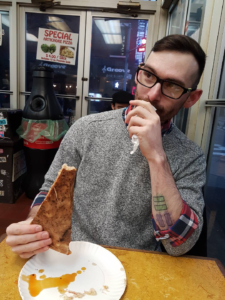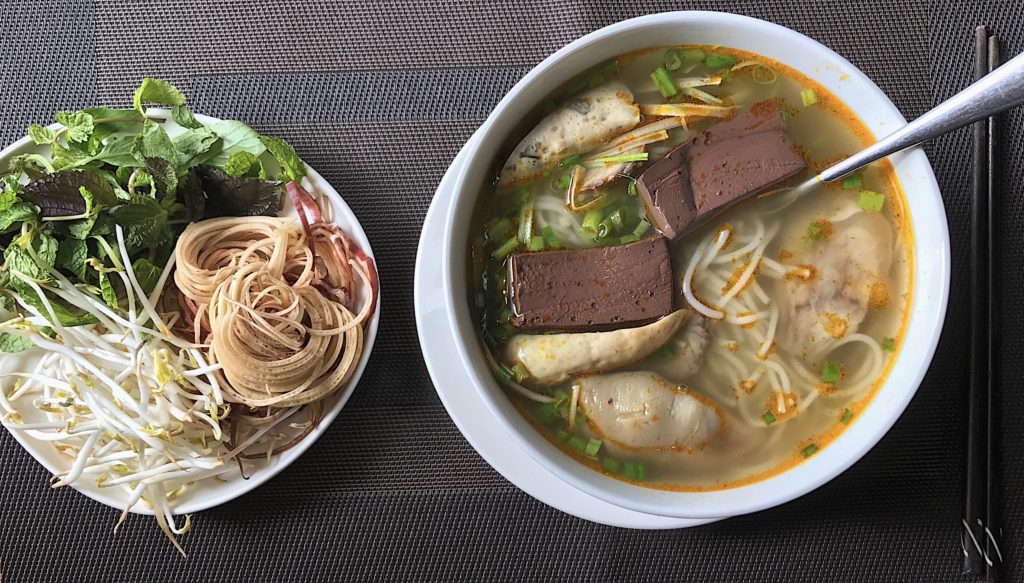The cook slaps a thin rectangle of glossy white dough against an aluminum counter. A loud thwack echoes throughout the small eight by twenty foot restaurant (the kitchen is half of that). He pulls the dough the length of his arms, which is long, and rips it in half. Like all good noodle dishes, this one is made to order. He puts the noodles into boiling water for a few minutes, then tosses them into a tapered sauce pan with lean slow roasted pork belly, pickled cabbage, and chili oil. Red oil, hóng yóu as it’s known in China, is its own condiments genre. Every restaurant, every home kitchen has its own recipe for hóng yóu. Some are spiced with anise and ginger, making them gentler and more flavorful. Others, like this one, are loaded with red chilies flakes and ground Szechuan peppercorns, making them bone searingly spicy.
A cook, one of two in the kitchen, dumps your noodles onto a Styrofoam plate. The red-orange chili oil pools at the bottom of the plate, glistening as it covers every centimeter of the food. The cashier calls your number, plastic tray in hand. You take the cheap plastic tray, a pair of disposable chopsticks, and a handful of napkins to the eating counter next to you. It’s one of two aluminum counters that run the length of the restaurant—one on the right wall, the other on the left wall—five metal and wood stools sit under each counter. The floor is concrete. The walls are white. The front door is cut from a large piece of glass—that also makes up the only window—which light pours through, filling the dining area and compensating for the few circular lights in the ceiling. The wall in front of you has two-dozen laminated pictures each one with a corresponding letter and number combination, the restaurant’s menu. The other wall has articles hung in bright red frames attesting to the restaurant’s quality.
You grasp the chopsticks with your hand and slurp. The shredded, grey pork belly is tender and flavorful. The noodles are wide, dense, and chewy, but the clock is ticking; if not eaten within fifteen minutes, they will soak up too much of the oil and turn soggy.
The edge of your lips tingle. You feel light headed and the urge to double over in pain from the scorch of the hell-oil, but you resist. Your face feels loose, like it’s melting off. You sit up every few seconds gasping for air, patting your forehead with a napkin, wiping the snot from your nose. Everyone’s face is like yours: red, contorting in pain, nose dripping snot. The tray is littered with sticky, crumpled white paper balls.
You take an occasional pull off your Japanese rice beer. The dry crispness fortifies you and you crack on, as they do, funneling noodles and pork belly into your mouth with chopsticks. The light green cabbage provides a crunch; the textural contrast that you want and need, but its relief is temporary. There’s not enough cabbage to extinguish the heat of the oil.
Every time you eat these noodles you promise yourself that you’ll never eat them again, that you’ll never expose yourself to their heat again. Now, your tenth time eating them, you willingly, lustfully, eat these noodles. In every bite there is pain and pleasure, there is burn and, albeit temporary, relief.
You finish eating, but the burn does not stop; it lingers. The last sips of your beer do nothing to loosen the capsaicin clamped to your taste buds. You dump your tray and walk to the subway. Four blocks away your endorphins take over. Your head goes numb; a cool sensation replaces the burn. You promise yourself that you’ll never eat those noodles again but you know you will.

Joseph Émile Bernard is a food writer living in New York. He is currently finishing his first novel and holds a BA in Writing from SUNY Plattsburgh and an MFA in Creative Writing from The New School. Follow him on Instagram: @notes_from_the_underbelly


Comments are closed.